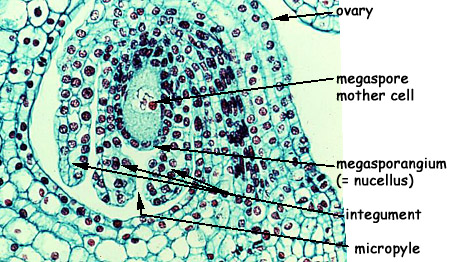Lily (Lilium) – Development of the Female Gametophyte (= embryo sac)
This information is additional information that will help more with lecture content than lab 😉
This is a cross-section through the ovary of a lily flower. It shows ovules each with one megaspore mother cell.
Below is a longitudinal section through the ovary showing again the ovules, but in a different orientation.
Here is a cross-section through a more mature ovary:
After meiosis four megaspores are produced (no cell walls form between them):
Three of the four nuclei migrate to one end and fuse together while the lone one migrates to the opposite end (micropyle end):
The triploid nucleus (formed from the fusion of the three nuclei) and the haploid nucleus (at the micropylar end) undergo mitosis:
After this first mitotic division the embryo sac contains 2 triploid and 2 haploid nuclei:
Below is the mature embryo sac. It contains 7 cells and 8 nuclei. See if you can determine this in the picture.
One of the main characteristics that sets the anthophytes apart from all of the plants we have been studying is double fertilization. The pollen tube delivers two sperm nuclei to an ovule. One sperm fuses with the egg to produce the zygote (and then ultimately the embryo). The second sperm fuses with the polar nuclei which gives rise to the endosperm.
In most textbooks the lily type of embryo sac development is presented. Go to the Polygonum-type (which is actually the most common type) to find out why people prefer to use the lily-type.
Development of the Female Gametophyte in Polygonum
Development of the Male Gametophyte (pollen grain) in Lily









